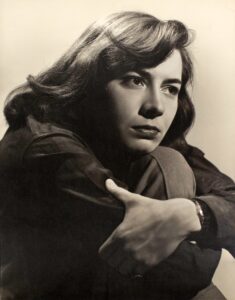Marking 100 years of Patricia Highsmith

Patricia Highsmith was born on this day 100 years ago. The American’s powerful and seductive crime fiction remains as relevant today as it ever has been.
Her debut novel, the psychological thriller Strangers on a Train, was released in 1950 to high praise – especially for her gripping, existential writing style.
Just a year later the book was adapted for the screen by Alfred Hitchcock, bringing Highsmith’s work to a larger audience. The riveting tale of how architect Guy Haines and the psychopathic Charles Bruno ‘exchange murders’ (Bruno offers to kill Guy’s unfaithful wife in return for Guy knocking off Bruno’s father) explored themes of identity and morality that Highsmith would become renowned for in the years that followed.
Her second novel would be just as dramatic, yet more personal. Writing under the pseudonym ‘Claire Morgan’, 1952’s The Price of Salt was a ground-breaking romantic lesbian novel that featured an unusual (for the time) happy ending. It was republished 38 years later as Carol, the eponymous main character being portrayed by Cate Blanchett in the 2015 film adaptation.
Highsmith’s work was gaining many high-profile plaudits, such as Truman Capote and Graham Greene, who labelled her ‘the poet of apprehension’. In 1955 Highsmith created one of the most iconic literary characters of all time in The Talented Mr Ripley, where the down-at-heel Tom Ripley senses a chance to start a new life by murdering a rich heir to a shipping company, who’s living a luxurious life in Italy, and stealing his identity. After Ripley lays on the charm and develops the courage to carry out the deed, he goes on to become a skilled con artist and serial killer in the later Ripley novels – Ripley Under Ground (1970), Ripley’s Game (1974), The Boy Who Followed Ripley (1980) and Ripley Under Water (1991).
But despite the literary success, life wasn’t easy. Writing became a form of escapism and clarity for Highsmith, who suffered a troubled existence away from the typewriter. She endured several cycles of severe depression, developing a cynical, lonely and hostile persona – worsened by her dependency to alcohol. The intimate sexual relationships she formed, mostly with women, didn’t last long.
In 1982 she moved from New York, where she’d lived since she was six, to Switzerland, where she lived a remote existence until she died in February 1995, aged 74.
She left behind a body of work – 22 novels and nine short story collections – that few authors could match in quality or meaning. Highsmith was brave enough to explore her own instincts, ambitions and fears within her fiction, which in turn made it easy for readers to identify with her flawed characters and their tales of forbidden love, complex personal liaisons or starting over, all laced with fascinating psychological intrigue.
